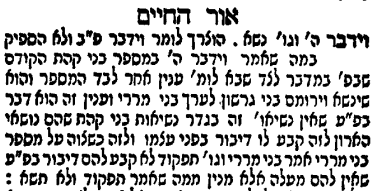Summary: Or HaChaim explains it as a special elevation to Gershon. I explain it as due to the interjection at the end of the instruction for Kehas.
Or HaChaim explains as follows:
 “It is necessary to say Vaydaber a second time, and it is not sufficient with what was stated Vaydaber Hashem in the preceding counting of the children of Kehas in parshas Bamidbar because it [the count of Gershon] comes to say another matter besides the count, and this is that they should lift up and elevate them over the children of Merari. And this matter is a thing in and of itself, for this ‘Nesius’ is not in the same domain as the ‘Nesius’ of the children of Kehas, who were the carriers (‘Nosei’) of the Aron. For this reason, a separate dibbur was established for him. And therefore, when he commanded the counting of the children of Merari, he said ‘the children of Merari… you shall count’ [Josh: but it does not say the word נשא like it does for the other brothers], it does not establish a dibbur by itself, for they have no ascendancy, but only a count, from that which it says Tifkod and not Tisa.”
“It is necessary to say Vaydaber a second time, and it is not sufficient with what was stated Vaydaber Hashem in the preceding counting of the children of Kehas in parshas Bamidbar because it [the count of Gershon] comes to say another matter besides the count, and this is that they should lift up and elevate them over the children of Merari. And this matter is a thing in and of itself, for this ‘Nesius’ is not in the same domain as the ‘Nesius’ of the children of Kehas, who were the carriers (‘Nosei’) of the Aron. For this reason, a separate dibbur was established for him. And therefore, when he commanded the counting of the children of Merari, he said ‘the children of Merari… you shall count’ [Josh: but it does not say the word נשא like it does for the other brothers], it does not establish a dibbur by itself, for they have no ascendancy, but only a count, from that which it says Tifkod and not Tisa.”
Post: Here is Or HaChaim on the first pasuk of parshas Naso:
The point he makes is that there is a separate dibbur for introducing the count of Gershon. That is, we have here a count of the families of the three sons of Levi.
Kehas is in parshas Bamidbar, in Bamidbar 4:1
:
The three are obviously a set, so why do Kehas and Gershon merit a separate dibbur while Merari does not?
In other words, there is a secondary meaning to the word נשא. It refers to an elevation rather than a count. And so we neatly explain why there is a special dibbur for Gershon at the same time that we explain the change in language by Merari.
I would explain the difference in a different way. The reason for the repetition of Vaydaber has nothing to do with Gershon, who was counted second, but with Kehas, who was counted first. Look at the full perek here to see the structure of the perek.
The structure is:
- Vaydaber
- Count Kehas
- Duties of Kehas
- Interjection (4: 17-20): Vaydaber: Kehas might die, Aharon and his sons should take these steps to prevent.
- Vaydaber
- Count Gershon also
- Duties of Gershon
- Count Merari
- Duties of Merari
The big change is in [IV] the interjection at the very end of parshas Bamidbar.
That this interjection requires a Vaydaber should indicate to us that this is indeed an interjection, and a change of topic. If so, then naturally we need a Vaydaber (and a gam hem) to return us to the initial topic.
However, there is no such interjection at the end of Gershon. And so we can go straight to Merari, without an introductory Vaydaber.
Or HaChaim further comments as follows:
"To Moshe: And there [before, by Kehas at the end of parshas Bamidbar] it states [the Moshe] and to Aharon. This because there the command comes to Aharon in order that he perform the seder which is stated in the matter of the burden of the children of Kehas, for it is written
וְשָׂמוּ אוֹתָם אִישׁ אִישׁ עַל-עֲבֹדָתוֹ, וְאֶל-מַשָּׂאוֹ. that they not die. Therefore it stated 'and to Aharon', while there is no necessity for this for the burden of the children of Aharon."
See above for the Vaydabers for Kehas and Gershon, to see one say "El Moshe veEl Aharon" and the other say "El Moshe". This explanation is plausible.
However, note that the command of vesamu osam has its own Vaydaber, directed to Moshe and Aharon. So why for the counting part and designation of duties part alone should Aharon be included? Perhaps because otherwise the separate instruction to Aharon would not make as much sense.
I would suggest an alternate explanation, that really even the second Vaydaber was to both Moshe and Aharon. But since the function of this is to recover from the interjection, a minimal Vaydaber will suffice.


1 comment:
See also Rabbeinu Ephraim.
Post a Comment